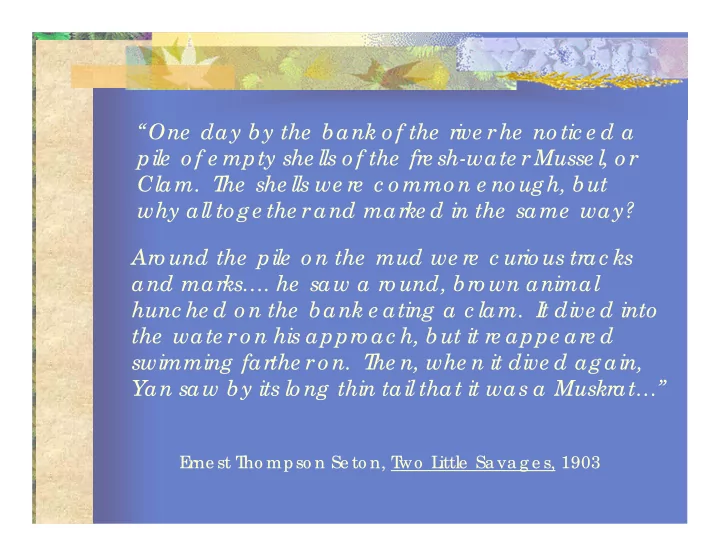

“One day by the bank o f the rive r he no tic e d a pile o f e mpty she lls o f the fre sh-wate r Musse l, o r Clam. T he she lls we re c o mmo n e no ugh, but why all to ge the r and marke d in the same way? Aro und the pile o n the mud we re c urio us trac ks and marks…. he saw a ro und, bro wn animal hunc he d o n the bank e ating a c lam. I t dive d into the wate r o n his appro ac h, but it re appe are d swimming farthe r o n. T he n, whe n it dive d again, Yan saw by its lo ng thin tail that it was a Muskrat…” E rne st T ho mpso n Se to n, T wo L ittle Sa va g e s, 1903
The mercury uptake and bioaccumulation by resident muskrats of the South River, VA JMU Graduate Student: Tiffany Tumer Thesis Advisor: Dr. Tom Benzing
Muskrat Ecology • Semi-aquatic mammal • Inhabits large variety of aquatic environments • Distributed across most of North America • Very prolific species • Lifespan of 3-4 years
Muskrat Ecology • Significant portion of diet in riverine muskrats is clams • Muskrat predation has inhibited recovery of endangered mussel in Clinch River • Corbicula mollusk of choice
Control Site: Middle River (Verona, VA)
Middle River
Study Site: South River (Dooms, VA)
Dooms Mill Pond South River
Results: Animals Collected Middle River South River N 12 13 Collection Dates December 7 – 14, 2005 January 6 – 8. 2006 Average age (months) 7.7 9.6 Sex 1 male, 11 females 10 males, 3 females
Tissue Analysis • Tissue type • Kidney • Liver • Muscle ( Biceps femoris ) • Future analysis • Brain • Hair • Claw • Tail • Procedures • Acid tissue digestion • Cold Vapor Atomic Absorption Spectrometry (CVAAS)
Results: Kidney 1.400 Mean Hg Concentration (ppm) 1.200 1.000 0.800 Middle River South River 0.600 0.400 0.200 0.000 Kidney Type of Tissue
Results: Liver 0.250 Mean Hg Concentration (ppm) 0.200 0.150 Middle River South River 0.100 0.050 0.000 Liver Type of Tissue
Results: Muscle 0.25 Mean Hg Concentration (ppm) 0.20 0.15 Middle River South River 0.10 0.05 0.00 Muscle Type of Tissue
Other Findings • Standard body measurements are similar between MR and SR muskrats • SR muskrats had livers (9 of 13) infected with multiple cestode cysts • SR muskrats had stomach contents that included clam tissue (9% by weight)
Conclusions • Significant differences exist in total Hg between MR and SR muskrats (kidney, liver, and muscle) • Poor correlations between Hg in tissues and: • Animal age • Animal sex • Body weight • Total body length • Slight correlation between Hg in liver, kidney and muskrat preference for clams • Kidneys contained significantly higher total Hg than liver or muscle samples
Thanks To…. • Michael Hensley • William Cook • Dan Downey • Larry Mohn • Jason Hallacher • Carney Tumer • Mike Fees • Hunter Joseph • Whit Wall
Questions?
Discussion, cont… • Hg concentrations measured in South River muskrat tissues, specifically the kidney, far exceeds any levels found in previous studies Mean Hg Concentration Study Tissue Type N (ppm) Halbrook et al. Kidney 30 0.019 Halbrook et al. Kidney 20 0.017 Halbrook et al. Kidney 26 0.011* Everett & Anthony Liver 14 0.029 Everett & Anthony Liver 18 0.039 Everett & Anthony Liver 20 0.053 Everett & Anthony Liver 11 0.070 * denotes control site Sheffy and St. Amant Liver 14 < 0.02 Sheffy and St. Amant Kidney 14 < 0.02 Sheffy and St. Amant Muscle 14 < 0.02
1.80 Concentration of mercury in kidney y = 0.0282x + 0.7084 1.60 R 2 = 0.2013 1.40 1.20 (ppm) 1.00 0.80 0.60 0.40 0.20 0.00 0 5 10 15 20 “Percent of stomach contents identified as clams”
0.35 Concentration of mercury in muscle y = 0.0037x + 0.1446 0.30 R 2 = 0.1214 0.25 0.20 (ppm) 0.15 0.10 0.05 0.00 0 5 10 15 20 “Percent of stomach contents identified as clams”
Recommend
More recommend